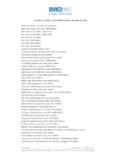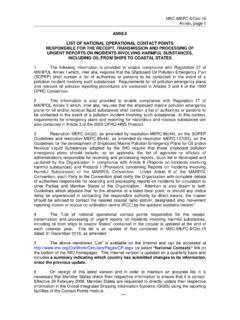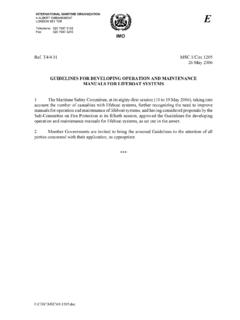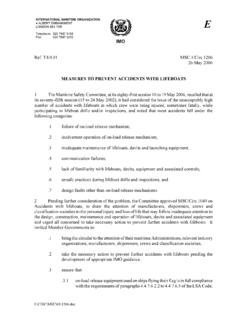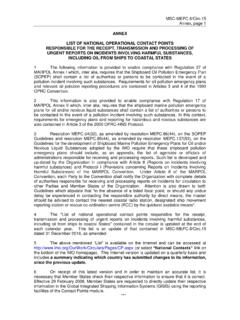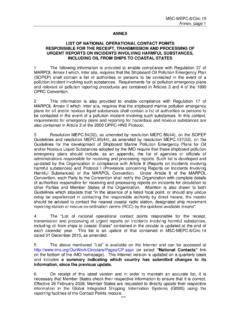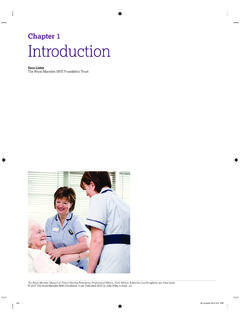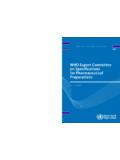Transcription of ships operating in polar waters - IMO
1 Electronic EditionLondon, 2010 guidelines FOR ships operating in polar waters 2010 Edition ELECTRONIC EDITIONP rint edition (ISBN: 978-92-801-1522-2) first published in 2010 by the INTERNATIONAL MARITIME ORGANIZATION 4 Albert Embankment, London SE1 7SR edition: 2010 IMO PUBLICATIONS ales number: E190 ECopyright International Maritime Organization 2010 All rights reserved. No part of this publication may be reproduced, stored in a retrieval system, or transmitted in any form or by any means, without prior permission in writing from the International Maritime publication has been prepared from official documents of IMO, and every effort has been made to eliminate errors and reproduce the original text(s) faithfully.
2 Readers should be aware that, in case of inconsistency, the official IMO text will .. vResolution (26) (adopted on 2 December 2009) .. 1 Preamble .. 3 Guide .. 5 Chapter 1 General .. 11 Part A Construction provisionsChapter 2 Structures .. 13 Chapter 3 Subdivision and stability .. 14 Chapter 4 Accommodation and escape measures .. 16 Chapter 5 Directional control systems .. 17 Chapter 6 Anchoring and towing arrangements .. 18 Chapter 7 Main machinery .. 19 Chapter 8 Auxiliary machinery systems .. 20 Chapter 9 Electrical installations .. 21 Part B EquipmentChapter 10 Fire safety .. 23 Chapter 11 Life-saving appliances and survival arrangements 25 Chapter 12 Navigational equipment.
3 29 Part C OperationalChapter 13 Operational arrangements .. 33 Chapter 14 Crewing .. 37 Chapter 15 Emergency equipment .. 38 Part D Environmental protection and damage controlChapter 16 Environmental protection and damage control .. 39vForewordOver the past 20 years, IMO has developed a raft of requirements, guide-lines and recommendations regarding polar ice-covered waters , concerning Arctic and/or Antarctic areas. These relate to maritime safety and prevention of marine pollution, as well as certification of seafarers on ships operating in polar areas. Navigation in polar waters was first addressed by the guidelines for ships operating in Arctic ice-covered waters , , approved by the Maritime Safety Committee (MSC) at its seventy-sixth session and the Marine Environment Protection Committee (MEPC) at its forty-eighth session, both in 2002.
4 These guidelines provide requirements additional to those of the SOLAS and MARPOL Conventions for navigation in Arctic waters , taking into account the specific climatic conditions in that area in order to meet appropriate standards of maritime safety and pollution MSC, at its seventy-ninth session in 2004, considered a request by the XXVIIth Antarctic Treaty Consultative Meeting for IMO to consider amend-ing the guidelines so that they would also be applicable to ships operating in the Antarctic Treaty Area and instructed its Sub-Committee on ship Design and Equipment (DE) to revise the guidelines its fifty-second session in 2009, DE finalized a draft Assembly resolution on guidelines for ships operating in polar waters , addressing both Arctic and Antarctic areas, which was approved by the eighty-sixth session of MSC and the fifty-ninth session of MEPC.
5 The guidelines were adopted by the twenty-sixth session of the IMO Assembly in December guidelines aim at mitigating the additional risk imposed on shipping due to the harsh environmental and climatic conditions existing in polar waters . They address the fact that the polar environment imposes additional demands on ship systems, including navigation, communications, life-saving appliances, main and auxiliary machinery, environmental protection and damage control, and emphasize the need to ensure that all ship systems both are capable of functioning effectively under anticipated operating conditions and provide adequate levels of safety in accident and emergency situations. In addition, the guidelines recognize that safe operation in such conditions requires specific attention to human factors, including training and operational procedures.
6 1 Resolution (26) Adopted on 2 December 2009 guidelines FOR ships operating IN polar WATERSThe Assembly,RecAlling Article 15(j) of the Convention on the International Maritime Organization concerning the functions of the Assembly in relation to regula-tions and guidelines concerning maritime safety and the prevention and control of marine pollution from ships ,RecAlling Also that, by circular , the Maritime Safety Committee and the Marine Environment Protection Committee, recognizing the need for recommendatory provisions applicable to ships operating in Arctic ice-covered waters , additional to the mandatory and recommendatory provisions contained in existing IMO instruments, approved guidelines for ships operating in Arctic ice-covered waters (hereinafter referred to as the guidelines )
7 ,noTing that the Maritime Safety Committee, at its seventy-ninth session, considered a request by the XXVIIth Antarctic Treaty Consultative Meeting (ATCM) to amend the guidelines to render them applicable to ships operat-ing in ice-covered waters in the Antarctic Treaty Area as well,Acknowledging that the polar environment imposes additional demands on ship systems beyond the existing requirements of the International Convention for the Safety of Life at Sea (SOLAS), 1974 and the International Convention for the Prevention of Pollution from ships , 1973, as modified by the 1978 Protocol relating thereto (MARPOL 73/78), as amended,Recognizing the need to ensure that all such systems are capable of functioning effectively under anticipated operating conditions and provide an adequate level of maritime safety and pollution prevention, taking into account the challenges of polar operations,noTing Also the need for a general update of the guidelines to take account of technical, technological and regulatory developments since their approval in 2002, guidelines for ships operating in polar waters2conscious of the necessity to also give special consideration to all ships that only visit polar waters at certain times of the year.
8 HAving consideRed the recommendations made by the Maritime Safety Committee at its eighty-sixth session and the Marine Environment Protection Committee at its fifty-ninth session,1. AdopTs the guidelines for ships operating in polar waters , set out in the annex to the present resolution;2. inviTes all Governments concerned to take appropriate steps to give effect to the annexed guidelines for ships constructed on or after 1 January 2011;3. encouRAges all Governments concerned to take appropriate steps to give effect to the annexed guidelines for ships constructed before 1 January 2011 as far as is reasonable and practicable;4. Recommends Governments to bring the annexed guidelines to the attention of shipowners, ship operators, ship designers, shipbuilders, ship repairers, equipment manufacturers and installers and all other parties concerned with the operation of ships in polar waters ;5.
9 AuThoRizes the Maritime Safety Committee and the Marine Environ-ment Protection Committee to keep the annexed guidelines under review and update them as necessary in light of experience gained in their ships operating in the Arctic and Antarctic environments are exposed to a number of unique risks. Poor weather conditions and the rela-tive lack of good charts, communication systems and other navigational aids pose challenges for mariners. The remoteness of the areas makes rescue or clean-up operations difficult and costly. Cold temperatures may reduce the effectiveness of numerous components of the ship , ranging from deck machinery and emergency equipment to sea suctions.
10 When ice is present, it can impose additional loads on the hull, propulsion system and Whilst Arctic and Antarctic waters have a number of similarities, there are also significant differences. The Arctic is an ocean surrounded by continents, while the Antarctic is a continent surrounded by an ocean. The Antarctic sea ice retreats significantly during the summer season or is dispersed by permanent gyres in the two major seas of the Antarctic: the Weddell and the Ross. Thus, there is relatively little multi-year ice in the Antarctic. Conversely, Arctic sea ice survives many summer seasons, and there is a significant amount of multi-year ice. Whilst the marine environ-ments of both polar seas are similarly vulnerable, response to such challenge should duly take into account specific features of the legal and political regimes applicable to their respective marine The guidelines for ships operating in polar waters (hereinafter called the guidelines )
